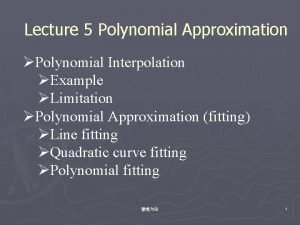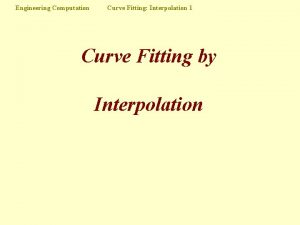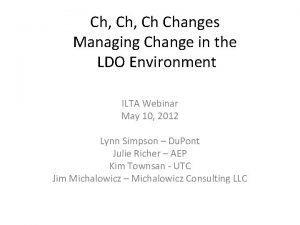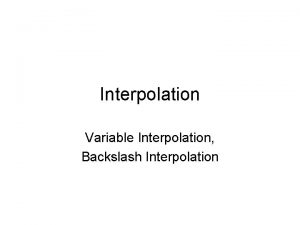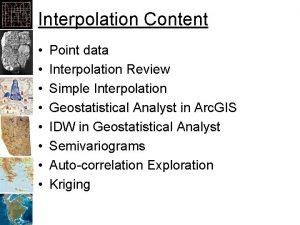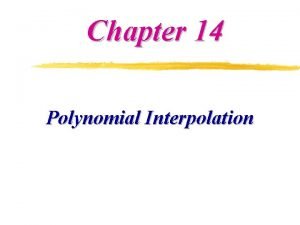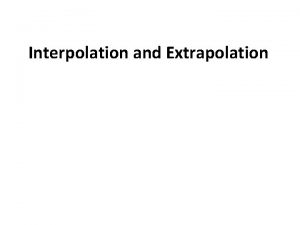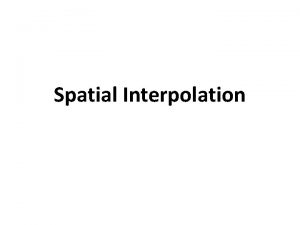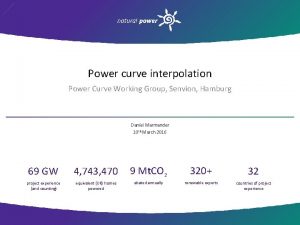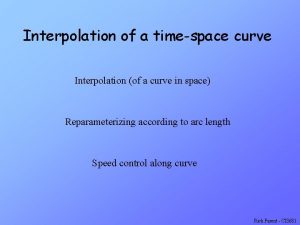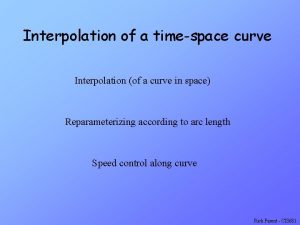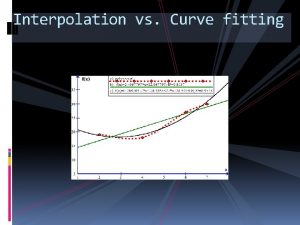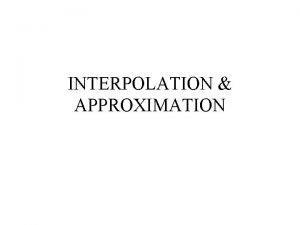Understanding the Power Curve Interpolation Issue Power Curve













- Slides: 13

Understanding the Power Curve Interpolation Issue Power Curve Working Group, 2016 -03 -10, Hamburg Axel Albers

Illustration of Interpolation Problem Source: P. Stuart, PCWG meeting London Dec. 2015 • Power curve raw data PActual(t) is first bin-averaged (baseline power curve in inner range) • Bin averages are interpolated in order to derive power from bin-averaged power curve for actual wind speed: PBaseline(t) or PCandidate(t) www. windguard. de 1

Inner Range Baseline Error Source: P. Stuart, PCWG meeting London Dec. 2015 • If NME is calculated for the inner range, it is expected to be zero (inner range baseline error) • But it isn’t: NME positive where power curve left-curved and negative where power curve right-curved www. windguard. de 2

Explanation of Interpolation Error • The cause of the non-zero inner baseline error is the difference of the bin average of the power curve raw data and the bin average of the interpolated data • The cause is not the lack of representation of the raw data by the bin averages (as illustrated in last meeting) www. windguard. de 3

Simulation of Effect • PActual(t): cubic increase of P with wind speed, cp=0. 45, cut-in wind speed of 3 m/s, 50 (100) values per 0. 5 m/s (1. 0 m/s) wide bin, equally distributed www. windguard. de 4

Simulation of Effect for 0. 5 m/s wide bins • Simulated inner range baseline NME significant at low wind speeds www. windguard. de 5

Simulation of Effect for 1. 0 m/s wide bins • Inner range baseline NME significantly increased compared to 0. 5 m/s bins www. windguard. de 6

Solution 1 to Overcome Effect (sophisticated) • Treat PActual in the same way as PBaseline and PCandidate: - First bin-average PActual(t): - Then interpolate bin averages according to actual wind speed: PActual, interpolated(t) • Calculate NME as: • The inner range baseline error is then zero by definition • The interpolation effect cancels out in e. Candidate or e. Baseline (outer range) as PActual, interpolated(t) undergoes the same interpolation as PCandidate(t) or PBaseline(t) (outer range) www. windguard. de 7

Solution 2 to Overcome Effect (simple) • Problem in case of linear interpolation between bin averages: two line assumptions with two slopes in each bin • Solution: use only one line per bin, which passes through bin average, Model in bin i: • Only issue: The model reproduces the exact bin average only if the wind speed is evenly distributed over the wind speed within the bin (is mostly the case). www. windguard. de 8

Time Series Approach for Wind Resource Assessment? • The interpolation problem is fully present if a bin-averaged power curve is used to simulate the power output based on a time series of the wind speed (overestimation of power at ankle of power curve, underestimation at knee) • No error occurs when using a bin-averaged power curve in combination with a frequency distribution of the wind speed for the calculation of the energy production • Consequence: The candidate methods may better be used only to transform the inner range power curve to the bin average of the meteorological variables (e. g. turbulence, shear) as present in the outer range. Alternative: The inner range power curve is transformed to different target values of the meteorological variables. The respective power curves in the outer range are then weighted by the frequency of each target value. www. windguard. de 9

First 4 Round Robin Tests of PCWG • The former round robin tests of the PCWG are not affected by the interpolation problem: - no power measurement was used - PActual(t) has been interpolated from a binned power curve - PCandiate(t) has been calculated based on PActual(t) - As PCandiate(t) and PActual(t) are affected in the same way by the interpolation, the effect cancels out in the comparison. www. windguard. de 10

Interpolation Effect was Present also at Relative Power Curve Analysis Original Self-Consistency Test in Training Period Improved Self-Consistency Test in Training Period • Approach of equal treatment of power curves helped to improve self-consistency test of Relative Power Curve Analysis www. windguard. de 11

Thank you contact: a. albers@windguard. de www. windguard. de 12
 Spline interpolation vs polynomial interpolation
Spline interpolation vs polynomial interpolation Curve interpolation formula
Curve interpolation formula Power angle curve in power system stability
Power angle curve in power system stability Change curve+awareness+understanding+acceptance+commitment
Change curve+awareness+understanding+acceptance+commitment Enduring issues essay outline
Enduring issues essay outline Enduring issues graphic organizer
Enduring issues graphic organizer Power traiangle
Power traiangle Hình ảnh bộ gõ cơ thể búng tay
Hình ảnh bộ gõ cơ thể búng tay Ng-html
Ng-html Bổ thể
Bổ thể Tỉ lệ cơ thể trẻ em
Tỉ lệ cơ thể trẻ em Chó sói
Chó sói Tư thế worm breton
Tư thế worm breton Chúa sống lại
Chúa sống lại
